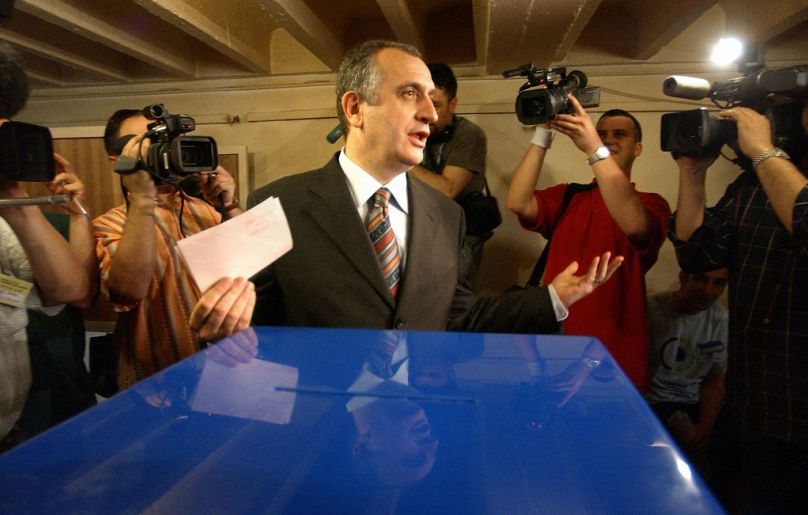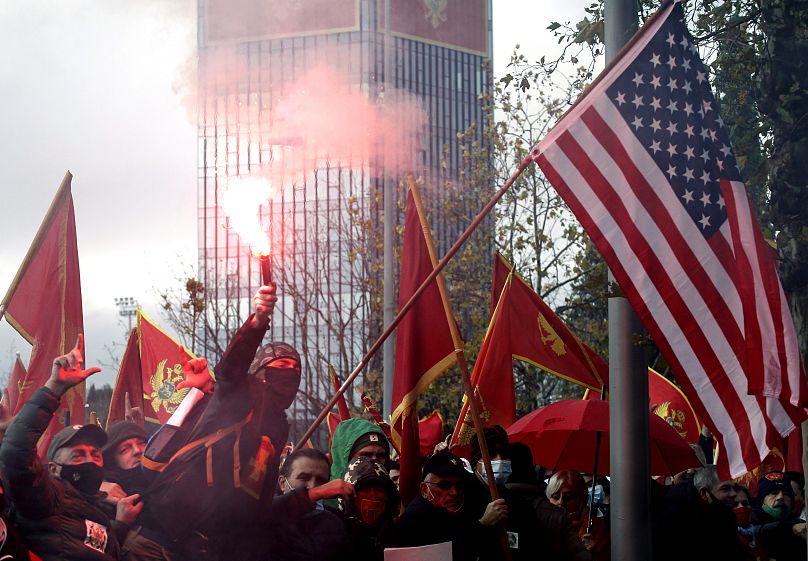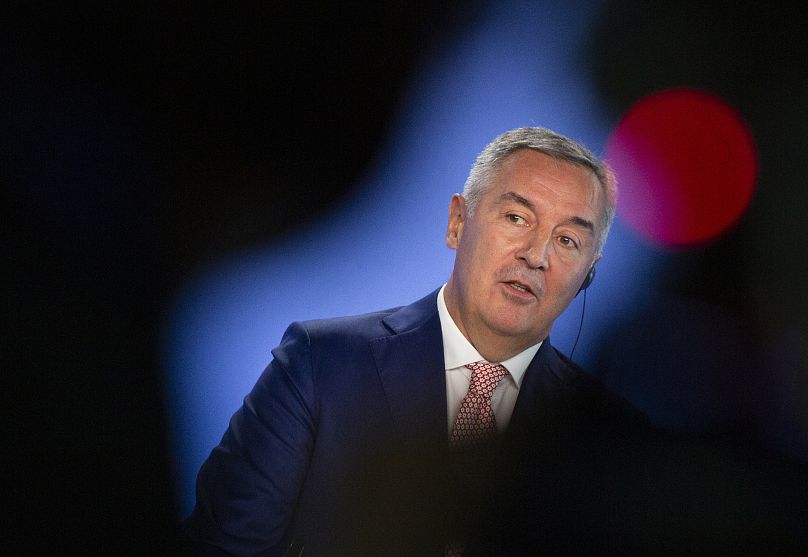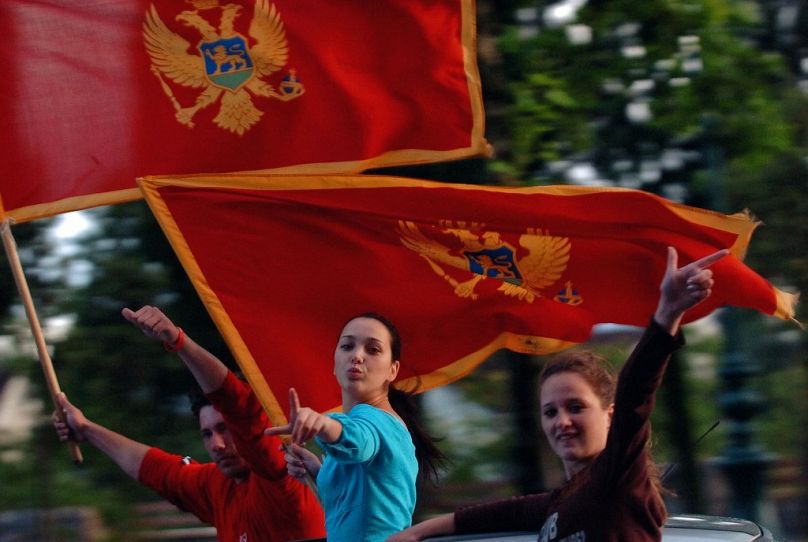The deep divide that was exposed by the referendum in 2006 still defines politics in Montenegro.
Hours after the polls had closed in Montenegro on 21 May, 2006, the head of the Balkan nation’s election commission told journalists that Montenegrins had voted by a margin of 55.4% to break from Serbia and become an independent state.
In normal circumstances, the result would have signified a close but conclusive result, but due to a quirk of Montenegro’s EU-sanctioned referendum, the yes campaign needed 55% to win.
Now the result was too close to call.
That did not stop Milo Djukanovic, Montenegro’s prime minister and architect of the independence campaign, claiming victory. In a speech to supporters, he said that 99% of votes had been counted and “only a few municipalities in Podgorica” remained.
He claimed that there were 6,000 votes left to count which “in no way can alter the result.”
Unsurprisingly, the man on the other side of the debate, Predrag Bulatovic, disagreed about the numbers. Bulatovic told his supporters that the result was 54%, a single percentage point short.
The electoral commission, meanwhile, said that the referendum would come down to 19,000 disputed votes in Podgorica.
Bulatovic and the coalition of unionists requested a recount, which was denied, and a few hours later the electoral commission announced that the final result was 55.5% in favour.
12 days later, on 3 June 2006, Montenegro declared independence from Serbia.
The result of the referendum was, ultimately, widely accepted. Serbia was one of the first nations to do so, followed by Russia, the European Union, the United States and the country’s Balkan neighbours, Croatia, Slovenia, and Bosnia and Herzegovina, whose own paths to statehood had led to the slow and bloody dissolution of the former Yugoslavia.
Montenegro had achieved its statehood democratically, and without a shot fired.
End of story.
Except it isn’t.
Exactly 15 years later and the deep divide that was exposed by the referendum in 2006 still defines politics in Montenegro. For Predrag Bulatovic, who led the unionist campaign, the wounds are still raw.
“It was irregular,” Bulatovic told Euronews. “I may even say that it was brutally robbed.”
Bulatovic stood down as leader of the opposition Socialist People’s Party (SNP) at elections in September 2006, when Djukanovic’s Democratic Party of Socialists (DPS) won a small majority off the back of the independence vote and with a promise to take Montenegro into the EU.
Bulatovic, who remains an MP and was a founder of the opposition Democratic Front, warned in 2006 that independence would turn Montenegro into a “black hole of Europe”, plagued by corruption and organised crime that would always prevent the country from joining Europe.
Fifteen years later, Bulatovic believes his fears have been realised.
“We are recognised as the country of endemic corruption, shady privatisation and crumbled institutions,” he said.
The Djukanovic era
Bulatovic attributes that primarily to one man, Djukanovic, who had dominated Montenegrin politics since 1991 and would continue to do so after 2006. His DPS won every election from 2006 up to 2020, taking Montenegro into NATO and maintained increasingly fractious relations with Belgrade. These were worsened still when Montenegro recognised Kosovo in 2008.
He was opposed by a vociferous opposition that was led by the hardline pro-Serbian nationalists that had led the unionist campaign in 2006. In 2016, 14 people were convicted of a plot to overthrow and murder Djukanovic on the eve of Montenegro’s parliamentary elections. It was alleged that both Belgrade and Moscow backed the coup attempt, although both have denied it.
In 2020, the fissure in Montenegro was again exposed in a row over the landholdings of the Serbian Orthodox Church, with the Djukanovic government wanting to force the institution to register its vast landholdings in Montenegro. The law led to street protests and ultimately, the defeat of the DPS in elections in August 2020 that gave the opposition power for the first time.
Like the referendum, last year’s election was won by the narrowest of margins, with the opposition winning a one-seat majority in parliament. But that has been enough to wage a bitter battle with the country’s special prosecutor, Milivoje Katnic - considered a Djukanovic ally, although he denies it - over corruption investigations into the DPS and its allies.
It has also seen a reset of relations with Belgrade and a controversial attempt by the new government to offer a path to Montenegrin citizenship for hundreds of thousands of long-term residents living in Serbia. Montenegrins in Serbia had previously been prevented from claiming their Montenegrin citizenship due to a ban on having dual nationality.
That dispute, too, is an old one. In 2006, Montenegro’s government successfully lobbied for a ban on Montenegrins residing in Serbia to vote in the referendum. In order to qualify voters had to have had a permanent residence in Montenegro for at least two years. The independence campaign felt - not unfairly - that Serbia-based voters would likely opt for a continued union.
The unionists, led by Bulatovic, were outraged by the decision, but it has been mirrored in other referendums since. In the 2014 Scottish independence referendum, for example, Scots living elsewhere in the UK were not permitted to vote.
Now, many in Montenegro fear that an influx of new citizens that were previously Serbian or reside in Serbia would tip the political scales towards the government and away from the DPS. There are even fears - although they have been publicly denied by even the pro-Serb nationalists - that the new government could seek to overturn the 2006 referendum altogether.
Djukanovic himself wanted ahead of the 2020 elections that the opposition wanted to overturn the 2006 results, and that a vote for it was a vote against Montenegrin independence.
Despite many of the more alarmist headlines since August 2020, not all those in the new government are Serb nationalists. The government is a broad church, made up of liberals, religious conservatives, nationalists and greens as well as a sizable Serb nationalist contingent.
As is the country: around 30% of Montenegro’s population identify as Serb, 50% Montenegrin, 9% Bosniak Muslim, and 5% Albanian, according to the 2011 census, the most recent.
Demographics were a key factor in 2006 when Serb-majority municipalities voted overwhelmingly to remain part of a union with Serbia and Montenegrin’s overwhelmingly to leave. In Pluzine, a Serb majority municipality near the Bosnian border, 80% voted no. In the historic Montenegrin capital of Cetinje - which is 91% Montenegrin - 86% of people voted yes.
But minorities too played a sizable - indeed, critics have alleged, an oversized - role in the triumph of the Djokovic-led push for independence. In Rozaje, which is overwhelmingly Bosniak, and in Ulcinj, which is majority Albanian, 90% of registered voters favoured independence. These are not small municipalities, together accounting for 26,000 yes votes.
Oversized, therefore, because in the middle of the referendum campaign the DPS pushed a law through parliament which increased the share of MPs allocated to minorities in the Montenegrin parliament. The law - which had been stalled for three years - was a clear incentive to encourage minority parties to back independence during the referendum.
And then there was Podgorica, the Montenegrin capital, whose 113,915 registered voters fell 53% to 47% in favour of independence. It was in Podgorica that votes were contested on election night and where finally the electoral commission pronounced the yes victory on May 22.
The questions surrounding those votes - and other alleged irregularities across the country - have not gone away all these years later. Although the Organization for Security and Co-operation in Europe (OSCE) was overwhelmingly positive in its June 2006 report - ranking 96.6% of the 86% of polling stations it visited as “good” or “very good”, problems were found.
Observers reported that 4% of the polling stations it visited had unsealed ballot boxes, while at 5% they witnessed voters marking their ballots outside of polling booths. They were also made aware of instances of people being paid to vote a certain way, and more still of voters taking photos of their ballot papers, which could indicate that they were being paid, the report said.
It particularly cited cases in Berane and Pljevlja, which were both no voting municipalities by margins of 1,350 (out of a total 24,000 voters) and 6,894 (out of 25,000) respectively. The limited convictions later secured for vote-buying all related to the independence campaign.
Although relatively minor occurrences - and despite a glowing final report from observers - these infractions have remained contentious given the margins. According to the letter of the law, 54.9% would have signified a loss, so the yes vote was ultimately carried by 0.6%, or 2,500 ballots.
'Overt political reasons'
In reality, however, 54.9% - or even 54% - would likely have led to a political stalemate and instability rather than a concession of defeat from the independence campaign. Djukanovic only reluctantly imposed the EU-imposed 55% threshold and even voices within Europe at the time were critical of it, including the official report by the Council of Europe.
“This was made for overt political reasons and would have created a crisis if the result had been, for instance, 54%,” wrote Lord Russell-Johnston, the council rapporteur for Montenegro. “The requirement should have been 50% +1.”
The European Commission has not replied to requests for comment from Euronews on what the political reasons were or why the condition was imposed, but a subsequent OSCE report suggested it was in order to ensure that if the independence campaign won, it was a decisive win rather than a question of a percentage point above 50% that could have been disputed.
Sinisa Vukovic, a lecturer at the School of Advanced International Studies (SAIS) at Johns Hopkins University, said that the EU acknowledged that anything between 50% and 55% would be a “gray zone” rather than an outright defeat of the independence campaign.
“In the gray zone, the tensions regarding status would continue. There was a tacit understanding from the EU that another referendum would be called within a few years due to clear support for independence, and unfairness of the 55% rule that was imposed,” Vukovic said.
History could have been very different for Montenegro and even the wider region had the yes campaign won 0.6% fewer votes on May 21. Serbia and Montenegro’s 2003 constitution provided for either partner to hold a referendum after three years of union. It further stated that if the referendum failed there would be a mandatory three-year wait before a rerun.
The three years following the referendum were a pivotal period for Montenegro and the wider region. In 2007, Montenegro signed a stabilisation and association agreement with the EU, beginning its path to membership of the bloc. In 2008 Montenegro recognised independent Kosovo, which had followed its lead in declaring independence from Belgrade.
In November 2010, the European Commission recommended that Montenegro be named as a formal candidate to join the European Union.
Unionists could counter that opposition to independence did not translate to hostility to Montenegro in Europe - and it is true that European flags were flown at both unionist and independence rallies. The difference with the unionist rallies was that alongside them were protesters wearing t-shirts with the faces of Radovan Karadžić and Ratko Mladić.
Mladic, a Bosnian Serb leader who led both the Siege of Sarajevo and the Srebrenica massacre, was still on the run in 2006 and Serbia’s failure to track him down continued to hamper Belgrade’s efforts to secure European Union membership. The country was not recognised as a candidate nation until 2011, the same year Mladic was detained in Serbia.
Montenegro's stalled path to Europe
European Union membership has overwhelming support in Montenegro, with recent polls putting it at more than 80%, compared to 63% in Serbia. After eight years of accession talks, all the 33 screened chapters have been opened, and three closed. A 2020 report by the European Commission noted progress on almost every chapter except freedom of expression.
That has always been the case in Montenegro which, unlike its neighbours, does not have a strong tradition of euroscepticism. What may have changed, though, is Montenegrin’s views on independence, with recent polls suggesting that 80% would vote in favour if it were held today.
But Montenegro’s recent change of political direction has many worried that opinions can change for the worse, too. The presence of hardened Serb nationalists in Montenegro’s government for the first time since independence and closer relations with increasingly nationalist Belgrade has already begun to have an effect on the discourse in the country.
A recent online campaign by the Ministry of Education and Culture, for example, includes a focus on promoting Serbian identity with Montenegro with the slogan: “We know who we are.”
“This all tells you that creation of the split in identity - which may eventually translate into anti-independence sentiments - is part of a political agenda,” said Majda Ruge, a senior policy fellow at the European Council on Foreign Relations (ECFR).
This could become all the more attractive to certain sectors of Montenegro if the EU accession process continues to stall and amid hostility in western Europe towards admitting new members from the Western Balkans. If European membership is off the table, perhaps a closer union with Montenegro’s historic partner Serbia isn’t such a bad thing after all.
“For me, the important question is what is the political agenda of the Belgrade-oriented political parties and does it overlap with the interests of the government in Belgrade,” said Ruge.
“How will that translate in concrete policies and discourse of the current government in which these parties participate over the next four years? Public opinion may not be split now, but in a couple of years it could be, as a result of [...] the manipulation of public opinion.”
Not together, but not apart
Bulatovic, once a unionist firebrand and now a Democratic Front MP, disputes that there are many voices in Montenegro today that would genuinely want to void the referendum and form a new union with Serbia. The unionists made their argument in 2006, and they lost. Now it is time to move on.
“I'm really sorry because of the split-up, but we must accept [...] reality. Montenegro is completely independent, and there aren't any political subjects who would want to talk about union again. As I'm aware, there are no such subjects in Serbia either,” he said.
If Serbia and Montenegro have a union again, Bulatovic said, it will as members of a far bigger project, the European Union.
“Montenegro is in negotiations with the EU, and Serbia wants the same thing. If we both become EU members, we can continue neighbour relations and our life together that way,” he said.
Every weekday, Uncovering Europe brings you a European story that goes beyond the headlines. Download the Euronews app to get a daily alert for this and other breaking news notifications. It's available on Apple and Android devices.















